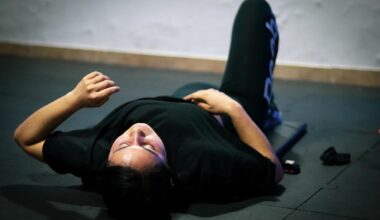Understanding Flexibility Training
Flexibility training is pivotal for athletes looking to excel in competitions. This discipline focuses on extending the range of motion in your joints and improving muscle elasticity. Flexibility enhances athletic performance, reduces injury risk, and aids in quicker recovery. When structuring a flexibility training schedule, it’s essential to identify the specific requirements for your sport. Incorporate various stretching techniques, such as dynamic, static, and PNF stretching, into your regimen. Each method serves distinct purposes within the overall flexibility spectrum. Dynamic stretches, particularly beneficial during warm-ups, prepare muscles for action. Static stretches, performed post-training, promote relaxation and muscle recovery. Meanwhile, PNF stretching, guided with a partner’s assistance, accelerates flexibility gains. Understanding the difference in stretch types will enable you to effectively sequence your workouts for optimal results. Consistency is crucial to success, so maintain a schedule that fits comfortably within your training routine. Like any skill, flexibility requires time and patience to develop, so stay committed to your regimen and monitor your progress to ensure continual improvement.
Assessing Your Current Flexibility Level
Before creating a training schedule, it’s vital to assess your existing flexibility levels. Start by testing various muscle groups, including hamstrings, hips, shoulders, and back. Utilize simple tests, such as the sit-and-reach test for targeting lower back and hamstring flexibility, or the shoulder stretch test for upper body assessment. These evaluations provide a clear baseline of your current flexibility, empowering you to set realistic goals. Document results meticulously and establish benchmarks to track improvements over time. Consider employing professional evaluations, such as those offered by personal trainers or physiotherapists, for more tailored insights. Once you’ve completed your assessments, identify any areas that require focused attention. Specializing your training schedule to target these weak points enhances overall performance and injury prevention. Remember, everyone’s body responds differently, so expect variability in progress. Incorporate your assessment insights into setting achievable milestones, motivating you toward your goals. Ultimately, your flexibility training schedule should evolve constantly based on these fundamental evaluations and the resultant progress made.
Creating a Weekly Flexibility Schedule
When designing your flexibility training schedule, aim for balance and variety across each week. A typical plan should encompass flexibility sessions at least three times per week, with the potential for daily short sessions. Each session should last between 20 to 30 minutes, focusing on warming up, stretching, and cooldown phases. Start with dynamic stretches to warm muscles, then transition into static stretches targeting specific areas identified during your assessments. Ensure you incorporate a mix of stretching techniques weekly to maximize benefits. A sample weekly structure could involve two sessions focusing on upper body flexibility, one session solely dedicated to lower body flexibility, and an additional session for total body agility. Ensure rest or light workout days surround intense flexibility sessions when needed. Additionally, document your schedule in a planner or digital format, allowing for easy adjustments as you progress. Flexibility training is particularly effective when integrated into overall workouts, providing consistent reinforcement of newfound ranges of motion while promoting muscle health and function.
Incorporating different training modalities, such as yoga or Pilates, complements your flexibility regimen effectively. Both practices emphasize stretching, posture, and core strength, making them excellent choices for enhancing flexibility. By merging these disciplines into your weekly training plan, you promote holistic fitness, preserving functionality and improved posture. Yoga, for instance, provides varied poses designed to stretch and strengthen, coupled with breathing techniques fostering relaxation and focus. Meanwhile, Pilates emphasizes core stability while improving flexibility, ideal for athletes needing to enhance their performance metrics. Adding at least one session of either discipline into your weekly lineup can lead to powerful results. Additionally, consider attending local classes or online sessions for guided expertise. Monitor your progress and note which segments yield favorable results, allowing you to fine-tune your schedule as necessary. Ultimately, such diversity fosters motivation and avoids monotony. Always remain receptive to modifications based on your evolving goals or physical response to training. Integrative training enables athletes to elevate flexibility while cultivating a broader skill set important for competition efficacy.
Tracking Your Progress
Monitoring flexibility gains is essential in maintaining motivation and hard-earned progress. Diligently record the results of your flexibility tests and how they change over time. Utilize a journal or a digitally accessible fitness app to document performance on predefined metrics, checking in every few weeks to evaluate improvements. By regularly assessing your flexibility, you not only notice growth but can also adapt your training schedule as needed to continue advancing. Additionally, ethical stretching forms and techniques should be emphasized during your evaluations to ensure the safest practice possible while working on mobility. Set specific, measurable goals alongside your routine, such as being able to reach further in the sit-and-reach test, holding specific stretches longer, or achieving advanced positions in yoga. When recording results, celebrate small victories, reinforcing motivation. Moreover, consider the mental aspects of flexibility training; reflecting on your journey strengthens commitment. Maintaining an adaptable mindset will support overcoming obstacles and enhance adherence to your training schedule. This will ultimately lead to successful competition prep, harnessing your improved flexibility to shine in your upcoming challenges.
Integrating Recovery and Nutrition
Recovery is a critical component of any flexibility training program, ensuring maximum benefits and preventing injury. After intensive stretching sessions, incorporate proper cooldown techniques to aid recovery, including light stretches and breathing exercises. Rest days are equally important to allow the body to recuperate and adapt. However, recovery doesn’t merely extend to the training schedule; nutrition plays a crucial role. Eating a balanced diet rich in nutrients, especially those supporting muscle recovery, will enhance flexibility gains. Focus on incorporating lean proteins, healthy fats, and an abundance of fruits and vegetables, containing vitamins and minerals crucial for muscle function. Hydration cannot be overlooked, as adequate water intake ensures optimal muscle elasticity during training. Including supplements to support flexibility, such as omega-3 fatty acids or magnesium, may also provide added benefits. Listen to your body’s needs—when feeling fatigued, don’t hesitate to give extra rest days or modify routines accordingly. Establish a post-session recovery routine involving stretching with foam rollers or massage techniques to speed up recovery. These strategies collectively promote overall wellness and allow sustainable flexibility gains over time.
In summary, developing a flexibility training schedule that aligns with your competition prep goals requires diligence and careful planning. Start by assessing current flexibility levels to customize your training effectively. Incorporate a varied weekly schedule focusing on techniques like dynamic and static stretches, ensuring ample recovery days and integrating complementary practices like yoga or Pilates. Tracking progress will aid in adjusting goals while simultaneously keeping motivation high for results. Remember, nutrition and recovery intertwine with flexibility training, building the foundation to foster maximal gains. By dedicating time to each aspect of the training schedule, you set yourself up for success in forthcoming competitions. Commitment and adaptability will ensure your flexibility program remains effective, maximizing performance and minimizing injury risk. Your hard work ultimately culminates in showcasing enhanced flexibility on competition day. Through structured preparation and continual assessment, you will develop essential skills and confidence and shine during each event. Stay positive, focused, and responsive to your body’s needs as you journey toward your competition goals. With a thoroughly crafted flexibility training schedule, you’re one step closer to achieving greatness.


